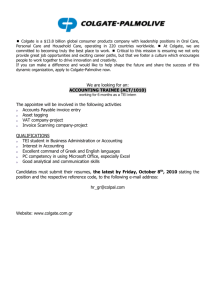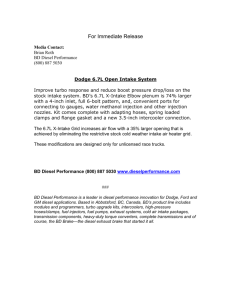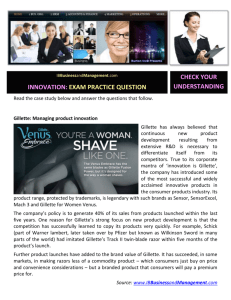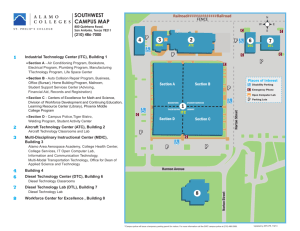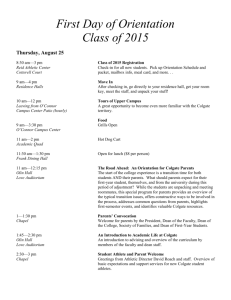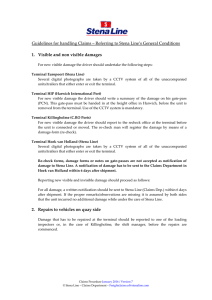MARKETING PRINCIPLES - Brief description of lectures What is
advertisement
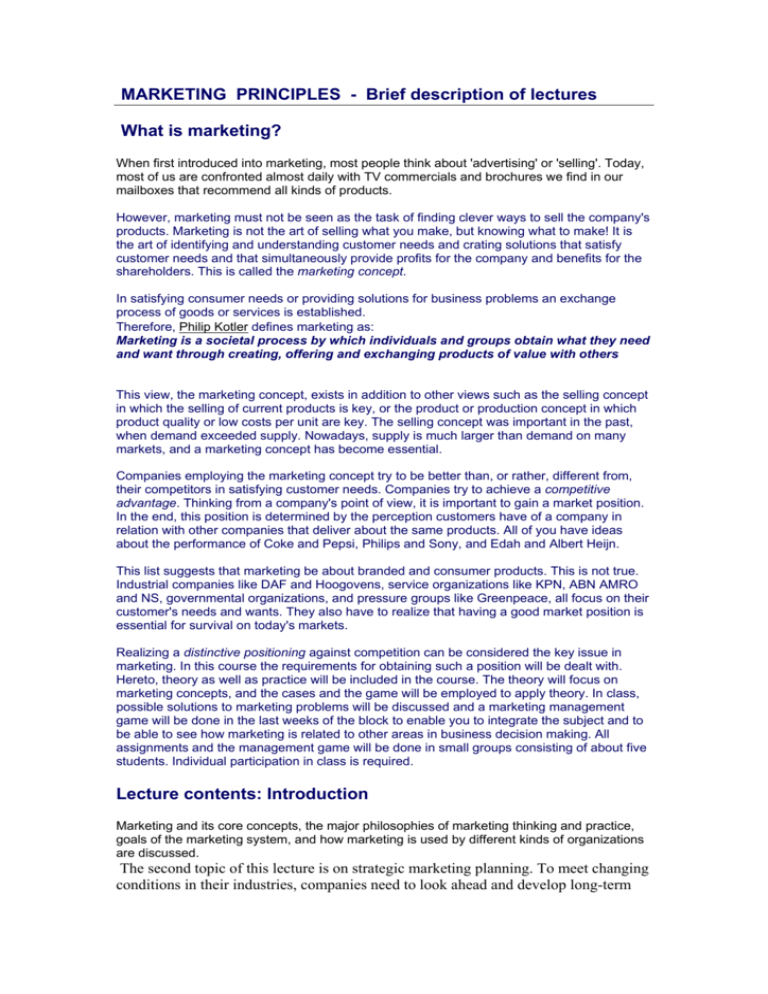
MARKETING PRINCIPLES - Brief description of lectures What is marketing? When first introduced into marketing, most people think about 'advertising' or 'selling'. Today, most of us are confronted almost daily with TV commercials and brochures we find in our mailboxes that recommend all kinds of products. However, marketing must not be seen as the task of finding clever ways to sell the company's products. Marketing is not the art of selling what you make, but knowing what to make! It is the art of identifying and understanding customer needs and crating solutions that satisfy customer needs and that simultaneously provide profits for the company and benefits for the shareholders. This is called the marketing concept. In satisfying consumer needs or providing solutions for business problems an exchange process of goods or services is established. Therefore, Philip Kotler defines marketing as: Marketing is a societal process by which individuals and groups obtain what they need and want through creating, offering and exchanging products of value with others This view, the marketing concept, exists in addition to other views such as the selling concept in which the selling of current products is key, or the product or production concept in which product quality or low costs per unit are key. The selling concept was important in the past, when demand exceeded supply. Nowadays, supply is much larger than demand on many markets, and a marketing concept has become essential. Companies employing the marketing concept try to be better than, or rather, different from, their competitors in satisfying customer needs. Companies try to achieve a competitive advantage. Thinking from a company's point of view, it is important to gain a market position. In the end, this position is determined by the perception customers have of a company in relation with other companies that deliver about the same products. All of you have ideas about the performance of Coke and Pepsi, Philips and Sony, and Edah and Albert Heijn. This list suggests that marketing be about branded and consumer products. This is not true. Industrial companies like DAF and Hoogovens, service organizations like KPN, ABN AMRO and NS, governmental organizations, and pressure groups like Greenpeace, all focus on their customer's needs and wants. They also have to realize that having a good market position is essential for survival on today's markets. Realizing a distinctive positioning against competition can be considered the key issue in marketing. In this course the requirements for obtaining such a position will be dealt with. Hereto, theory as well as practice will be included in the course. The theory will focus on marketing concepts, and the cases and the game will be employed to apply theory. In class, possible solutions to marketing problems will be discussed and a marketing management game will be done in the last weeks of the block to enable you to integrate the subject and to be able to see how marketing is related to other areas in business decision making. All assignments and the management game will be done in small groups consisting of about five students. Individual participation in class is required. Lecture contents: Introduction Marketing and its core concepts, the major philosophies of marketing thinking and practice, goals of the marketing system, and how marketing is used by different kinds of organizations are discussed. The second topic of this lecture is on strategic marketing planning. To meet changing conditions in their industries, companies need to look ahead and develop long-term strategies. Marketing plays an important role in strategic planning since it provides information and other inputs to help prepare the strategic plan. Marketing Environment The second lecture takes a closer look at the marketing environmental factors. The central issue is the ‘core marketing system’ (i.e. the environment in which the marketing activities of the organization take place). Important parts of the ‘core marketing system’ are the competitors and the consumers. During this lecture, special attention will be paid to competition. Central issues are doing a competitor analysis and formulating competition strategies. Within this framework we pay attention to the Product Life Cycle of a product. The consumer, or customer analysis will be explained in the next lecture. Consumer Behavior Marketing can be shortly described as the customers directed thinking and acting of an organization. This means that the customer plays a central role in the marketing thinking. During this lecture the customer or consumer has a central role. First attention will be paid to the behaviour of the consumer. On the basis of a simple consumer behaviour-model we will gain an insight into the most important factors that prescribe the buying behaviour. Then a closer look will be taken at the way people segment markets, how they can make a choice out of these segments (targeting) and in what way an organization can position itself in the chosen segment (positioning). Product Product is a complex concept that needs to be carefully defined. Product strategy calls for making coordinated decisions on product items, product lines and the product mix. Each product item offered to customers can be viewed on three levels: the core product, the actual product and the augmented product. Companies have to develop strategies for the items in their product lines. They must decide on product attributes, branding, packaging, labeling, and product-support services. Most companies produce a product line instead of a single product. Product mix describes the set of product lines and items offered to customers by a particular seller. The product mix can be described by its width, length, depth and consistency. Price Despite the increased role of the non-price factors in the modern marketing process, price remains an important element in the marketing mix. Many internal and external factors influence the company's pricing decision. Internal factors include the firm's marketing objectives, marketing mix strategy, and organization for pricing. External factors that influence pricing decisions include the nature of the market and demand, competitors' prices and offers, and factors like the economy, reseller needs, and government actions. In the end, the customer decides whether the company has set the right price. The customer weighs the price against the perceived value of using the product. If the price exceeds the sum of the value, customers will not buy the product. Marketers often vary their pricing strategies for different price segments. The company can select one of three general pricing approaches. These include the cost-based approach, the buyer-based approach, and the competitionbased approach. Pricing is a dynamic process. Companies design a pricing structure that covers all their products. They change it over time an adjust it to account for different customers and situations. Pricing strategies usually change as the product passes through its life cycle. Some pricing strategies include skimming and penetration pricing. When a firm is considering a price change, it must consider customers' and competitors' reactions. The firm that faces a price change initiated by a competitor must try to understand the competitor's intent as well as the likely duration and impact of the change. Promotion Promotion is one of the four major elements of the company's marketing mix. The main promotion tools are advertising, sales promotion, public relations and personal selling. They all work together to achieve the company's communication objectives. In preparing the marketing communication, the communicator has to understand the nine elements of any communication process: sender, receiver, encoding, decoding, messages, media, response, feedback, and noise. The company also has to decide how much to spend for promotion. Finally, the company has to divide the promotion budget among the major tools to create the promotion mix. Companies are guided by the characteristics of each promotion tool, the type of product/market, the desirability of a push or pull strategy, the buyers' readiness state, and the product life-cycle stage. The different promotion activities require strong coordination for maximum impact. Three major tools for mass promotion are advertising, sales promotion, and public relations. They are mass marketing tools as opposed to personal selling, which targets specific buyers. Advertising is a strong promotion tool. European Union countries spend around 45.4 billion each year on advertising. Advertising decision making is a five-step process consisting of setting objectives, budget decisions, message decisions, media decisions, and evaluation. Sales promotion covers a wide variety of short-term incentive tools such as coupons, premiums and buying allowances designed to stimulate consumers, the trade, and the company's own sales force. Public relations is gaining favorable publicity and creating a favorable company image. It is the least used of the major promotion tools, although it has great potential for building awareness and preference. Distribution Distribution channel decisions are among the most complex and challenging decisions facing a firm. Each channel system creates a different level of sales and costs. Once a distribution channel has been chosen, the firm must stick with it for a long time. The chosen channel strongly affects, and is affected by, the other elements of the marketing mix. Available means vary from direct selling to using one, two, three, or more intermediary channel levels. Channel design begins with assessing customer channel-service needs and company channel objectives and constraints. The company then identifies the major channel alternatives in terms of the types of intermediaries, the number of intermediaries, and the channel responsibilities of each. In the last years, direct marketing has become more important. Direct marketing consist of direct communications with carefully targeted individual customers, often a one-to-one, interactive basis, to obtain an immediate response. Today database technologies and new media, e.g., the Internet, permit sophisticated direct marketing. Integration – Marketing Practice Marketing can be applied in domestic as well as international markets. Customers can be consumers as well as businesses. Also services are marketed. All issues that are important in current marketing practice. It is not possible to treat all subjects exhaustively. Two subjects are becoming more and more important nowadays: international marketing and services marketing. Both subjects will be treated in class. The case focuses on integration of the subjects you learned in the previous weeks and it will cover the whole strategic marketing planning process. BIC versus Gillette: The Disposable Wars Subject What is Marketing? Short description At Gillette Company they know that an average man’s beard grows 0.04 cm a day (14 cm per year) and contains 15,500 hairs. During an average lifetime, a man will spend 140 days scraping 8.4 metres of whiskers from his face. Gillette even uses electron microscopes to study blade surfaces and miniature cameras to analyse the actual shaving process. At BIC they do not have microscopes. Neither do they know, and they do not even want to know, how many hairs the average beard contains. Still the disposable razor from BIC is the most important competitor of Gillette in years. The Internet The information on the Internet sites of these companies does not necessarily correspond with the information in the case. Use the sites to learn more about the companies and their products. Also, observe how these companies use the Internet in their marketing practice. • • BIC in the United States (www.bicworldusa.com/) The Gillette Company in the United States (www.gilette.com/) Questions Question 1 a. Does BIC use the marketing concept? Why (not)? And Gillette? Why (not)? b. What are the advantages and disadvantages of both concepts? Question 2 Why would BIC, even though it was a completely different marketing strategy then Gillette, still be the largest threat in years for Gillette? Question 3 a. Which needs are being satisfied by Gillette? And which wants? b. How about BIC? Question 4 To compete with BIC on the bottom of the market, Gillette introduced ‘Good news’. Give your opinion on this action. Question 5 a. Make a SWOT-analysis for Gillette. b. Gillette’s competition position is based on what? c. Which important conclusions derive from the SWOT-analysis? Question 6 According to Ansoff organizations can grow in different ways. Give an example of market penetration, market development, product development and diversification for Gillette. Stena Sealink versus Le Shuttle, Eurostar and the rest Subject Environment of the organization, competition Short description In July 1994 the Channel Tunnel between Folkestone and Calais is being opened. At Stena Sealink the atmosphere is tense, because of the particularly intensive competition caused by this opening. Ferry companies have got a new competitor. In a stable market with a relatively low competition level, all of a sudden a price-war broke out. How can developments in a certain environment of an organization have such a dramatic influence? Can organizations influence the situation or can they just react on the actual and anticipate on the future developments? The Internet The information on the Internet sites of these companies does not necessarily correspond with the information in the case. Use the sites to learn more about the companies and their products. Also, observe how these companies use the Internet in their marketing practice. • • • • • The Stena Line Group The Eurostar international site The Eurostar site, targeted at the United Kingdom. The Eurostar site of the Belgian railroads. The official Eurotunnel site (www.eurotunnel.com/) Questions Question 1 Describe relevant developments in the macro environment of Stena Sealink. Question 2 Describe the market in which Stena Sealink operates. Think about size, growth, profitability, seasonal pattern, and product lifecycle. Question 3 Identify and describe the most important players in the microenvironment of Stena Sealink. Question 4 Organisations always operate in a market form. What influence does Stena Sealinks market form have on its marketing strategy. Include the 4 P's in your answer. Question 5 Give an overview of the most important strengths and weaknesses of Stena Sealink. Question 6 Give an overview of the most important opportunities and threats of Stena Sealink. Question 7 Which strategy do you suggest for Stena Sealink to follow and why? Base your answer on the SWOT analysis. Feinschmecker Sauce: Pricey and Spicy Subject Consumer behavior Short description Uncle Ben's rice is the market leader in the Austrian market for part boiled rice. According to a survey, 75 per cent of the Austrian households knew the brand, a figure that increased to 95 per cent for the aided recall. And 50 per cent of them claimed that Uncle Ben's was their preferred brand. Uncle Ben's many brand strengths made its owner, Master Foods Austria (MFA), think it was the ideal vehicle for brand extension. On the basis of associations that customers had with relation to the brand, a couple of ideas of brand extension were being examined. Especially developments in the living and eating habits of groups of customers were important in the definition of the final choice. The Internet • • • • Uncle Ben's site USA (www.unclebens.com/) Uncle Ben's site UK (www.unclebens.co.uk/) Master Foods in Australia, where the company was founded. (www.masterfoods.com/) Master Foods Netherlands (www.masterfoods.nl/) Questions Question 1 Uncle Ben's tries to persuade potential customers to buy their Feinschmecker sauce. In order to do this they use the marketing mix elements. Describe how Uncle Ben's applied these elements for Feinschmecker. Question 2 Not only marketing mix elements employed by Uncle Ben's influence whether customers will buy Feinschmecker sauce or another product. Other aspects, such as cultural, social or technological factors are also important in the customers decision process. Describe which factors might influence the potential buyers of Feinschmecker sauce and give examples. Question 3 Attitudes and beliefs influence people's buying behaviour. Attitudes are not the same for all people. Describe attitudes towards ready-to-eat food for two groups of people. Suggestion: take your own attitude as starting point for one of the groups. Question 4 Is the buying process the same if customers buy a car instead of a sauce? Explain. Question 5 Give a description of a scenario in which consumers buy a product for the first time (first buy). Question 6 Compare your answer on question 5 with a situation in which customers buy a product for the 10th time (repeat buy). Coffee-Mate Subject Segmentation, targeting Short description The UK coffee creamer market has grown consistently since the first creamers were introduced in the early 1970's. However, since then the marketplace has changed. More women are included in the workforce, there is more health consciousness, people are aware of the benefits of low fat and the disadvantages of higher sugar intake. These aspects have all contributed to a further segmentation of the market. In the coffee creamer market Coffee mate (a Nestle product) is the market leader and they want to stay in this position. In the case several areas are addressed such as, Coffee Mate benefits, marketing strategy, segmentation methods, positioning and promotion. The Internet • • • Nestlé international site (www.nestle.com/) Coffee-mate pages of the U.S. magazine Better Homes and Gardens Carnation site for the United States (Carnation is the umbrella brand for Coffee-matewww.carnationmilk.com/) Questions Question 1 Identify potentially successful and threatening (current and future) developments in the direct and indirect environment of Coffee Mate. Question 2 Mention strengths and weaknesses in the coffee creamer market and in the market of its substitutes. Question 3 Mention strengths and weaknesses of Coffee Mate relative towards its direct competitors. Question 4 Based on which criteria did TGI segment the British market? Question 5 Make an overview of the segments defined by TGI. Question 6 Which segmentation strategy is currently used by Nestle? Question 7 Are the segmentation criteria used by Nestle the same as those employed by TGI? Why or why not? Question 8 Which of the segments found by TGI are interesting to target now or in the future? Take e.g., into account segment attractiveness and company fit. Question 9 Which segments would you choose to target and how would you position the product within these segments? Question 10 Which changes are to be made in Nestles marketing mix strategy given your new positioning? Question 11 Mention some strengths and weaknesses of your chosen positioning strategy and the positioning currently chosen by Nestle (think about their commercial). Colgate: one squeeze too many? Subject Product Short description With the arrival of new distribution channels for medicines like supermarkets and mail order companies the number of supplier has increased too. The margins on medicines are still very attractive. Colgate/Palmolive is following these developments very closely. Everyone knows Colgate toothpaste. But what would the customer think of Colgate medicines? Does this fit within the current assortment? What does the customer really buy when he/she buys a tube of toothpaste? And what role do the brand name and the packaging play in the final choice? The Internet • • Colgate-Palmolive Company US site (www.colgate.com/ Colgate German site (www.colgate.de/) Questions Question 1 a. Colgate aims at what segment(s) when they bring Over The Counter (OTC)-medicines into the market? b. What should be the best way to position themselves? Question 2 a. In the case they write that OTC-medicines normally have a long life cycle. With the defining of the life cycle we are on the level of the product class. On what other levels can we handle the definition of the life cycle? b. What factors could turn the scale for the long life cycle of OTC-medicines? Question 3 You are the marketing manager at Colgate. Two of your products, toothpaste and OTCheadache-tablets, are each in a different stage of the life cycle. Indicate what this means for the filling in of each marketing instrument. Question 4 a. Describe Colgate OTC-headache-tablets in terms of care, actual and augmented product. b. On what level can Colgate get their most important competitive advantages? Question 5 Give the advantages and disadvantages of entering the market of medicines under the name Colgate. Question 6 a. Describe the length, depth and consistency of the assortment of Colgate-Palmolive (see http://www.colgate.com). b. Do the OTC-medicines fit into this assortment? Proton MPi: Malaysian styling, Japanese Engineering and European pricing Subject Price Short description The (too?) high prices that car producers ask for their new models bring about that in 1994 the private segment for new cars in England collapsed. Crazy enough the car rental companies and fleet buyers were responsible for the high prices that the customer had to pay. They could bargain for considerable reduction because of their size and with that their strong negotiation position vis-a-vis car producers. Car producers have to collect their profit somewhere so they make private car owners suffer for it. Proton MPi leaps into this development easily. The company has to make an important decision: lower the price to increase the sales or keep the price fixed and keep a fair margin on every sold car. The Internet The information on the Internet sites of these companies does not necessarily correspond with the information in the case. Use the sites to learn more about the companies and their products. Also, observe how these companies use the Internet in their marketing practice. • • International Proton site (www.proton.com/) Proton UK site (www.proton.co.uk/) Questions Question 1 Is Shem justified in his concern about being charged too much for new cars in the United Kingdom? Question 2 a. What explains the big difference between EU and US car prices? b. Does the price demand function vary from country to country in Europe and is that in the United States completely different? Question 3 a. How should Proton price its cars? Should it keep its list prices high, reduce them or give big discounts to buyers? b. Why might giving discounts be better than lowering the list price? Question 4 What is likely to happen if Proton cuts its prices to gain market share? Question 5 Clearly there is currently no pan-European price, nut should that ever exist across the EU? Should the car companies continue with what are essentially national policies? Diesel jeans & workwear: 'We're all different. But aren't we all different in the same way' Subject Promotion Short description During the oil crisis in 1978, the idea of a trademark called Diesel came to Renzo Rosso, the son of an Italian farmer. In 1985 he decided to produce and sell clothes that he himself liked to wear; clothes that represented his lifestyle. His wild and masculine 'Renzo Rosso style' is what Diesel Jeans & Workwear is all about. Via communication (supply information) does the multinational Diesel try to stimulate the sales. They not only communicate with the customer, but also with other parties concerned. How could Diesel fill in their promotion mix? The Internet • • International Diesel site (www.diesel.com/) Diesel UK shop site (ukstore.diesel.com/) Questions Question 1 The first step of effective communication is the identification of the target group. Give as accurate as possible a description of the target group(s) of Diesel. Question 2 How does Diesel position itself on the Jeans market? Compare this positioning with the positioning of Levi’s. Question 3 a. (See this advertisement below) Here you see one of the advertisements of Diesel that has been used to communicate with the target group. What goal does Diesel want to pursue with this advertisement? b. This way of communication aims at what attitude-component? c. What would the communication have looked like if it was aimed at another attitudecomponent? Question 4 Give a description of the way on which rational, emotional and moral appeals return in the advertisement of Diesel. Question 5 What is the score of the advertisement of Diesel to the points of attention with respect to the message format that are mentioned on page 765 of the book? Question 6 a. What instruments of the promotion mix does Diesel use besides advertising? b. What criteria are of influence on the choice of the instruments? Question 7 Diesel uses standard forms of advertisements all over the world. Give your opinion on this policy. Advertisement Bang & Olufsen: different by design Subject Distribution Short description In 1983 the relationships between Bang & Olufsen and their German dealers were difficult. Bang & Olufsen’s turnover in the individual shops was so small that it did not matter to the dealer. Also, since turnover on the German market accounted for only 3 per cent of Bang & Olufsen turnover in the Danish parent company, the German market was not significant to Bang & Olufsen either. The question had to be made: ‘Should B&O concentrate on selling in the most profitable markets and close the German subsidiary?’ or ‘Should it re-establish and reposition the brand following a new marketing strategy?’. What role can the chain level play in this choice? The Internet • • International B&O site (www.bang-olufsen.com/) B&O centre Rob Schipper Dutch shop site (www.beoshop.nl/) Questions Question 1 The market share of B&O in Germany in 1983 is very low. In what ways can the distribution policy of B&O contribute to a higher market share? Question 2 B&O had an important strategic choice to make in 1983: leave the German market or invest in the market to increase the sales. What would you have done and what is that depended on? Question 3 Distinguish between the old push and the new pull policies followed by Bang & Olufsen since 1984. a. What would have been the reasons that B&O started to manipulate the market via a push strategy? b. Why do you think the push strategy was not working? Question 4 Does the switch from push strategy to pull strategy solve the problems that B&O have on the German market? Question 5 In many sectors we see a shift in power from the manufacturer to the retailer. a. What factors would play a role? b. Give your opinion on the shift of power within the trade column of B&O? Question 6 In what way can B&O dealers fill in the function they have within the trade column? KitKat: Have a break... Subject Strategy Short description The chocolate market is a concentrated, stable and highly competitive market. The UK market is dominated by Cadburys, Nestle Rowntree and Mars who together share 68% of the market. Nestle Rowntree is the largest confectionary company. It sells to over 120 countries and is the largest exporter of chocolate and sugar confectionary. The case is about Kit Kat. Kit Kat is sold in two formats in the UK, namely a two-finger and a four-finger. The two-finger is sold in the CBCL sector, the four-finger in the countline sector. In addition, European retailers sell Kit Kat minis. This portrays the diverse markets in which the company operates and the complexity of arriving at a comprehensive marketing plan. The Internet The information on the Internet sites of these companies does not necessarily correspond with the information in the case. Use the sites to learn more about the companies and their products. Also, observe how these companies use the Internet in their marketing practice. • • • Nestle international site (www.nestle.com/) KitKat site Japan (www.kitkat.co.jp/) KitKat site Spain (kitkat.nestle.es/) Questions Question 1 Describe the target groups for the 'two-finger' and the 'four-finger' Kit-Kat. Question 2 Why are the 'two-finger' and the 'four-finger' Kit-Kat marketed in a different way? Question 3 Mention the most important differences in the marketing mixes for the 'two-finger' and the 'four-finger' Kit-Kat. Question 4 Make a SWOT analysis for Kit-Kat. Question 5 Mention a least three strategic options that follow from this SWOT analysis. Question 6 Elaborate on one of these options. Write a plan which includes a description of (1) the target group, (2) the positioning and (3) the use of the marketing mix elements.
